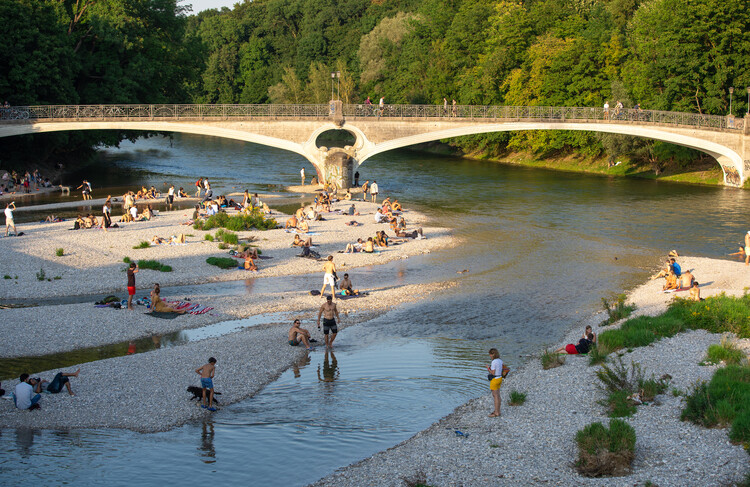
In 1988, Jacques Chirac made a never-fulfilled promise to make swimming accessible in the Seine River within 5 years. With swimming in the Seine officially banned by the French government in 1923, the river has been neglected for decades, flooded with high levels of bacteria and pollution resulting from industrialization and urbanization. With the XXXIII Olympic Games happening in Paris, Mayor Anne Hidalgo has drafted a “Swimming Plan,” aiming to finally transform the Seine River into a swimmable urban waterway. The billion-dollar effort outlines the river as a venue for this summer’s aquatic Olympic events.
Throughout history, rivers played a crucial role in the social structures of cities. Along riverbanks, communities often congregated for socializing, swimming, and fishing. Swimming in rivers was a popular summertime activity enjoyed by people of all ages. Whether it was the Thames in London or the Seine in Paris, rivers were bustling with swimmers; integrated into urban lifestyles.

According to the European Environment Agency, the development of European urban rivers has been extremely negatively affected by urbanization. It has resulted in significant changes to many urban rivers, including canalization, burial, or confinement. Additionally, many urban waterways have been transformed into containers for sewage, pollutants, and other forms of wastewater, posing serious public health hazards. Today, Europe’s rivers are filled with organic chemicals. According to The Guardian, “hundreds of river sites around the world, from the Thames to the Tigris, are awash with dangerously high levels of antibiotics.”
Meanwhile, rivers are seen as the lifeline of European cities. Two billion people worldwide use river water for drinking. Whether it is their historical significance, water and food supply, or ecological value, rivers hold a significant role in cities. With today’s climate crisis at a new high, rivers offer the potential to mitigate modern risks associated with flooding and drought, specifically in urban settings. The overall degradation of urban rivers through toxic pollutants, diseases, and bacteria has underscored the urgent need for environmental conservation and pollution control measures to restore these vital lifelines to their former glory.
Several European cities are leading the way in clean water rivers and river restoration projects. Across Europe, numerous river swimming spots are clean, safe, and accessible. For decades, cities like Basel, Bern, Zurich, and Geneva have been successfully reclaiming their rivers, transforming them into swimmable and safe waterways. Interestingly, developments since the 1980s included creating sewage treatment facilities and directing domestic effluent away from the river.
They also included concrete steps for easier access to the water and guidelines and maps issued for swimmers. The River Limamt stands out as an interesting case study, where locals can enjoy a dip in clean waters at the heart of the urban landscape. Acting as a cherished cultural gathering and pastime activity, Swiss “Badi-Kultur” or Bathing Culture is accessible to all from May to October, operating daily.

Additionally, Munich’s Isar River is a testament to successful river restoration efforts. According to the New York Times, the restoration effort was first initiated in 2000 and included purifying the river’s waters, enlarging floodplains, and improving its banks. The 38 million-dollar restoration project transformed the Isaar into a public space where locals and tourists alike take leisurely swims in its clean waters.

In Berlin, an urban development project aims to revitalize and change the 1.8km of the Spree Canal that is currently unused. “Flussbad Berlin’s” primary goal is to clean up this portion of the river, creating direct public access to the canal. The plan incorporates a public swimming area, which will be established between the Bode Museum and the Humboldt Forum on Museum Islands.
In London, the “Thames Tideway Project” is on a mission to reconnect London with the River Thames. Relying on a 150-year-old sewer system, London is currently dumping millions of tonnes of raw sewage spills into the River Thames each year. Thames Tideway is on a mission to build a 25km Super Sewer under the Thames to clean up the river. Additionally, the architect and founder of Studio Octopi, Chris Romer-Lee, has been working to increase the recreational use of the River Thames and reintroduce swimming. The proposal focuses on specific stretches of the river where an open-air swimming pool would be positioned.

In conclusion, the health of rivers is essential to the planet's overall health. Rivers are cultural placeholders, social activators, and gathering spots. More importantly, they sustain vibrant ecosystems, offering essential habitats for aquatic species and aiding in preserving biodiversity. A healthy river could be used as a defense against incoming climate impacts, offering cost-effective flood protection and access to clean water supplies.
However, with rapid urbanization and industrialization, many metropolitan rivers are now filled with pollution, sewage, and other forms of wastewater. Despite these obstacles, several European cities are setting the standard for river restoration, reclaiming their status as hygienic, accessible, and safe waterways. The potential of urban river revitalization is demonstrated in the efforts to convert the waterways from Munich to Zurich into recreational zones.

Moreover, initiatives like the “Swimming Plan” for the Paris Summer Olympics demonstrate the increasing understanding of the value of clean waterways for both recreational and environmental reasons. In fact, river restoration and conservation are crucial as we continue to address the climate issue. Last month, the New York governor announced a partnership with Friends of + POOL to open the first urban river-sourced swimming facility in the United States, to provide New Yorkers with access to free and safe river swimming.











